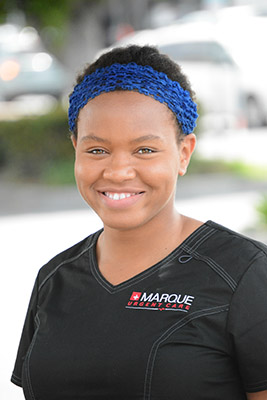
AC Separation (Collar Bone and Shoulder Blade) by Milinda Ajawara
 An acromioclavicular joint separation commonly known as an AC separation, occurs when the collar bone (clavicle) separates from the shoulder blade (scapula). This injury occurs more frequently in men than women (5:1 ratio) who play contact sports (i.e. football, rugby, hockey, soccer) or sustain a direct fall on their shoulder point.1 There are six different classifications for
An acromioclavicular joint separation commonly known as an AC separation, occurs when the collar bone (clavicle) separates from the shoulder blade (scapula). This injury occurs more frequently in men than women (5:1 ratio) who play contact sports (i.e. football, rugby, hockey, soccer) or sustain a direct fall on their shoulder point.1 There are six different classifications for 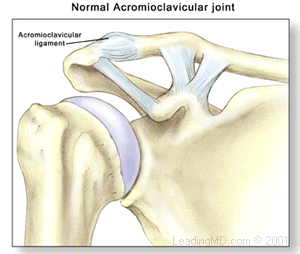 an AC separation ranging from mild dislocation (grade I-III) to complete separation (grade IV-VI) – all depending on which supporting structures are damaged.2 The most common AC joint injuries are those classified grades I-III, while grades IV-VI are uncommon and usually are the result of moto-vehicle accidents. Grades IV-VI all require surgical treatments because of the severe disruption of all ligaments and soft tissue supporting the arm and shoulder.1,2
an AC separation ranging from mild dislocation (grade I-III) to complete separation (grade IV-VI) – all depending on which supporting structures are damaged.2 The most common AC joint injuries are those classified grades I-III, while grades IV-VI are uncommon and usually are the result of moto-vehicle accidents. Grades IV-VI all require surgical treatments because of the severe disruption of all ligaments and soft tissue supporting the arm and shoulder.1,2
The most common type of AC joint injury is a grade I which is a slight displacement of the joint due to direct force on the shoulder. In a grade I injury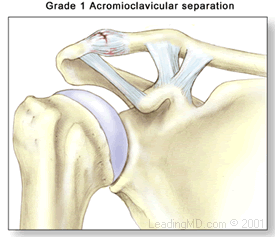 the AC ligament is strained with possibilities of a partial tear or stretching.2 Grade I injuries can be successfully treated by non-surgical methods which focus on reducing swelling and pain, as well as resting and protecting the area. This type of injury usually requires 1-2 weeks of rest, anti-inflammatory medications, icing the area, and physical therapy sessions with gentle exercises to promote healing and normal ranges of motion.1,2
the AC ligament is strained with possibilities of a partial tear or stretching.2 Grade I injuries can be successfully treated by non-surgical methods which focus on reducing swelling and pain, as well as resting and protecting the area. This type of injury usually requires 1-2 weeks of rest, anti-inflammatory medications, icing the area, and physical therapy sessions with gentle exercises to promote healing and normal ranges of motion.1,2
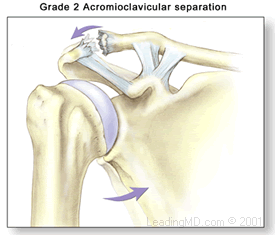 A grade II injury is a partial joint dislocation with a complete tear of the acromioclavicular ligament. This is one of the ligaments connecting the clavicle to the scapula which is another connecting ligament, and the coracoclavicular ligament, still remains connected. 2 The treatment for grade II is similar to the grade I, which is non-surgical treatment involving a sling for immobilization, icing, and rehabilitation exercises to regain range of motion and strength.1,2
A grade II injury is a partial joint dislocation with a complete tear of the acromioclavicular ligament. This is one of the ligaments connecting the clavicle to the scapula which is another connecting ligament, and the coracoclavicular ligament, still remains connected. 2 The treatment for grade II is similar to the grade I, which is non-surgical treatment involving a sling for immobilization, icing, and rehabilitation exercises to regain range of motion and strength.1,2
A grade III injury is a total separation caused by complete tearing of the acromioclavicular and coracoclavicular ligaments of the AC joint. Grade III injuries can easily be identified by a bump on the shoulder, a result of the clavic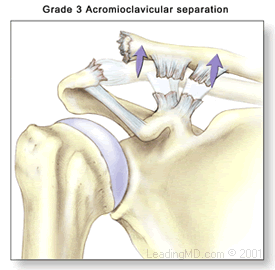 le being pushed up due to the shoulder being dragged down by the weight of the arm.2 It is still controversial whether a surgical or non-operative approach is best for treating grade III injuries. It has been suggested that non-operative treatments are best for those who have higher chances of re-injury, while surgical stabilization is recommended for individuals with lower reoccurrence chances who want to participate in activities that require frequent overhead movements. 1,2
le being pushed up due to the shoulder being dragged down by the weight of the arm.2 It is still controversial whether a surgical or non-operative approach is best for treating grade III injuries. It has been suggested that non-operative treatments are best for those who have higher chances of re-injury, while surgical stabilization is recommended for individuals with lower reoccurrence chances who want to participate in activities that require frequent overhead movements. 1,2
Reference
- Augustus D. Mazzocca, MD, Robert A. Arciero, MD, JamesBicos, MD. Evaluation and Treatment of Acromioclavicular Joint Injuries. The American Journal of Sports Medicine. Vol 35, Issue 2, pp. 316 – 329. November-17-2016
- The Steadman clinic. AC Separation. Accessed 01/08/2017.https://www.thesteadmanclinic.com/patient-education/shoulder/ac-separation
The information provided is for general interest only and should not be misconstrued as a diagnosis, prognosis or treatment recommendation. This information does not in any way constitute the practice of medicine, or any other health care profession. Readers are directed to consult their health care provider regarding their specific health situation. Marque Medical is not liable for any action taken by a reader based upon this information.
